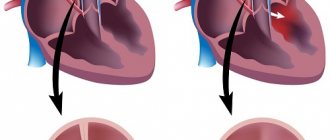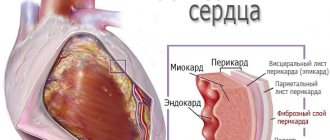Features of malignant headache
What is malignant hypertension? It is a constant pressure above 220 to 130 mmHg.
It is accompanied by:
- Damage to the retinal vessels, leading to blindness;
- Secondary kidney damage.
The danger of the form lies in severe complications and death. Malignant headache accounts for only 1% of all registered cases of the disease.
The main cause of malignant arterial hypertension is symptomatic hypertension.
Its development is provoked by:
- The presence of inflammatory processes in the adrenal glands. Sharply increases blood pressure levels, and against the background of pheochromocytoma, hypertension develops in 40% of cases;
- Disruption of the renal vessels. As a result, blood flow to the kidneys decreases and the release of harmful substances increases;
- Parenchymal kidney diseases;
- Tumors and scleroderma;
- Primary form of aldosteronism.
Malignant headache is less likely to develop against the background of Cushing's and Conn's syndrome.
The concept of malignant hypertension
The disease is quite rare. It affects approximately 1% of patients suffering from high blood pressure. Mostly, malignant hypertension occurs in people who have not treated the disease. Often a malignant form of pathology develops as a secondary disease.
Men under 40 years of age are susceptible to pathology. After 60 years, the risk of getting sick decreases to almost zero. Malignant hypertension occurs against the background of glomerulonephritis and renal pathologies. Most patients do not know what malignant hypertension is and do not contact a specialist if they find persistently elevated blood pressure. This aggravates the treatment and prognosis of the pathology.
Causes of the malignant form of hypertension
The disease can develop into a malignant form during its development. The exact causes of the development of the disease have not yet been determined. It has been established that the trigger mechanism for the malignancy of the disease is destructive processes in the cardiovascular system. The most likely cause of the development of pathology is considered to be stenosis (narrowing) of the renal arterial vessels.
Damaged kidneys produce a number of substances that are dangerous to the body. These substances contribute to a constant increase in blood pressure. In this situation, the production of hormones that dilate blood vessels is disrupted.
Malignant hypertension develops as a result of such pathologies:
- Pheochromocytoma, or inflammatory processes in the tissues of the adrenal glands. As a result of these processes, substances are formed in the organ that cause a sharp and stable increase in blood pressure. The probability of developing malignant hypertension against the background of pheochromocytoma is about 50%.
- Parenchymal pathologies of the kidneys.
- Renovascular hypertension. This is the name for a disorder of the blood vessels in the kidneys. The blood supply to the organ is gradually disrupted, and the blood flow to it decreases. The pressure in the kidneys decreases, they release toxic substances in large quantities.
The following risk factors for the development of degeneration of benign hypertension into malignant hypertension are identified:
- Smoking. Because of this addiction, the ability of blood vessels to expand and contract is impaired. All smokers are at risk of developing a malignant form of hypertension.
- Alcohol consumption. This substance causes sharp fluctuations in blood pressure. This negatively affects the condition of the heart and blood vessels. Ethanol causes damage to all organs. It is important for patients at risk to completely abstain from drinking any types of alcoholic beverages.
- Endocrine disorders.
- Pregnancy. Malignant arterial hypertension can occur in women in the later stages of pregnancy.
- Unfavorable genetic inheritance. A person is at high risk of developing hypertension if his relatives suffered from constant high blood pressure.
- Intense physical activity and overwork can cause a permanent increase in blood pressure. This is due to the fact that the body cannot rest adequately, which is why its blood vessels are constantly in a tense state.
- Stress, psychological problems and emotional overload contribute to an increase in blood pressure. In some cases, they remain elevated for a long time.
- Age factors.
Important! The presence of at least one predisposing factor contributes to the development of a malignant form of hypertension in a patient.
Signs of illness
Its insidiousness is that it may not appear in the early stages. A person may find that he becomes tired more often and quickly, and he cannot perform the same amount of work. However, it is difficult to determine whether a patient has a malignant form of hypertension based on this sign alone. A person begins to use drugs to support the immune system, strengthening compounds. They do not affect slowly progressive hypertension.
Groups at risk for developing MH
The main risk factors for developing the disease:
- Smoking;
- Consumption of alcoholic, tonic, energy drinks;
- Overwork, heavy physical labor, non-compliance with work and rest schedules;
- Increased level of emotional stress, regular stress, depression.
The risk group for the disease also includes older people: their body wears out quickly, and age-related changes occur that affect the functioning of the heart, blood vessels, and kidneys. The risk of the disease increases sharply if among relatives there are cases of kidney, cardiovascular or vision diseases.
Complications due to improper treatment
It is strictly prohibited to treat diseases such as malignant hypertension on your own. Only an experienced specialist will be able to prescribe the necessary course of treatment, select medications for each patient individually, which will have an exclusively positive effect on the body. If you treat the disease incorrectly or do not follow the required dosages, you may encounter the following additional diseases:
- Cardiac ischemia.
- Blindness. Stroke.
- Heart failure.
- Heart attack.
- Heart rhythm disturbances.
- Ischemic kidney disease and others.
This is not a complete list of diseases that can occur as a result of improper treatment of hypertension. In order not to once again expose yourself to danger and not to provoke the occurrence of other concomitant diseases that can result in death, you must:
If you notice symptoms of the disease, consult a doctor immediately. Carry out all prescribed actions and take the necessary medications. Follow the diet prescribed by your doctor. Completely give up bad habits, especially during treatment. Establish physical activity.
Not every person knows what malignant hypertension is, which is why in many cases the problem is not immediately recognized. If you experience some of the symptoms described above, you should immediately seek help from a doctor who can diagnose this disease. Remember, the sooner a problem is identified, the faster and more effectively you can get rid of it and enjoy life in a healthy body.
Symptoms
At the first stage, malignant hypertension can manifest itself as overwork or chronic fatigue. Main symptoms of the disease:
- Sharp and sudden deterioration of vision up to blindness;
- Double vision, frequent photopsia;
- Migraines and severe headaches accompanied by nausea;
- Weakness, rapid fatigue, inability to concentrate on anything for a long time;
- Sudden weight loss without changes in diet or diet;
- Decreased appetite;
- Reduced body temperature;
- Sleep disturbance;
- Swelling resulting from kidney pathologies;
- Fainting and convulsions;
- Paleness of facial skin;
- Increased blood pressure in the evening and at night;
- Disorders of the digestive system, leading to vomiting, diarrhea, constipation.
With a rapid increase in blood pressure, diseases of internal organs quickly develop, and the symptoms of hypertension expand depending on the affected targets.
Classification
The malignant form of hypertension is less common than other types of hypertension, so there is no expanded classification of the disease. There are two main types of malignant hypertension: primary and secondary.
- Primary hypertension is an increase in blood pressure that is caused by genetic predisposition and poor lifestyle. Primary malignant hypertension is rare, only about 2-4% of the total number of patients is recorded.
- Secondary hypertension is an increase in blood pressure that is caused by other diseases. These may be diseases of the endocrine system, kidneys, heart, vascular lesions, long-term use of medications that affect blood pressure.
Identifying the type of malignant arterial hypertension is important for drawing up a treatment regimen.
Consequences of MH
Complications of malignant arterial hypertension occur with late diagnosis and failure to follow doctor’s recommendations. The main danger of the disease is the development of a stroke. Poor blood circulation in the brain is also a cause of loss of consciousness and coma. The consequences of a stroke can be disability and death.
Other dangerous complications are hemorrhage in the eyeball and retinal detachment. This can cause blindness and damage to the optic nerves. Renal dysfunction due to decreased blood supply leads to heart attacks and necrosis, acute renal and heart failure, and angina.
Deterioration of blood supply to the heart muscles leads to the development of coronary artery disease.
Causes
It is not always possible to determine the causes of malignant hypertension . In some cases, it is associated with genetics, and, as a rule, appears only in adulthood.
When the causes of the disease are clear and they speak of symptomatic arterial hypertension, this means that the clinical picture is caused by another pathology, for example:
- In very rare cases, a kidney tumor.
- In 10%, kidney tissue is affected.
- In 10% , primary aldosteronism is a formation in the adrenal cortex that actively synthesizes aldosterone, which increases blood pressure.
- In 30% , renovascular hypertension is damage to the renal vessels, as a result of which the amount of blood delivered to them is reduced. At the same time, the kidneys produce many elements that raise blood pressure.
- In most cases - more than 50% - malignant hypertension is associated with pheochromocytoma, a neoplasm in the adrenal medulla that produces catecholamines, substances that increase blood pressure.
If malignant hypertension is caused by a complex of causes, the prognosis becomes less favorable.
In addition, a jump in blood pressure may have the following reasons:
- water-electrolyte balance disorder;
- heart or kidney failure;
- renal artery stenosis;
- microangiopathies.
Diagnosis of malignant form
If you have one or more symptoms, you should consult a cardiologist or therapist and undergo an examination. Necessary diagnostic procedures:
- Blood and urine tests;
- Measurement of pulse and pressure dynamics;
- Ultrasound of the thyroid gland and kidneys;
- Visit to an ophthalmologist;
- Hormone analysis.
Based on the results of the mandatory examination, the doctor may refer the patient to:
- Listening to heart rate;
- Conducting daily blood pressure monitoring;
- ECG;
- Ultrasound of the main blood vessels and renal vessels.
If a set of studies reveals abnormalities, additional tests and examinations are prescribed to identify renal parenchyma, renal artery stenosis, Cushing's or Conn's syndrome, and coarctation of the aorta.
Symptoms and its features
If we talk about the specific manifestations of the disease, then almost all people will experience the following symptoms:
- headache - it can be localized in the occipital or temporal region of the head. It intensifies with emotional or mental stress. Severe pain may indicate a hypertensive crisis;
- pain in the heart area - they are usually aching in nature, and there may be a feeling of squeezing in the chest. Sometimes a person is tormented by short-term stabbing pains;
- dizziness;
- noise in ears;
- cardiopalmus;
- the appearance of “floaters before the eyes.”
Headaches due to hypertension
Usually, all the symptoms together appear very rarely, only when it comes to a severe form of the disease. In its initial stages, a person may simply experience a headache, sometimes tinnitus, and a slight increase in heart rate. In this case, you should consult a doctor who can explain in detail what hypertension is and how to treat it.
Diagnosis and treatment
As for diagnosing the disease, a person is first prescribed blood pressure monitoring and an ECG. The most effective is daily monitoring, which is performed using a special device that practically does not restrict the patient’s movement.
It was mentioned above that hypertension is often a consequence of some primary disease, so a vascular diagnosis, examination of the heart and kidneys will be carried out. Clinical samples are also taken.
If we talk about treatment, it will be aimed primarily at stabilizing blood pressure. For this purpose, diuretics are prescribed - diuretics.
Basic methods of treating the disease
Together with urine, they remove salts from the body that retain water, thus contributing to increased blood pressure.
The main thing is to use diuretics with extreme caution, because in this case the task is to gradually reduce pressure, because a sharp drop can be dangerous to health
Also, many patients are prescribed sedatives to stabilize their emotional state. Of course, they will be quite effective, because stress most often provokes an increase in blood pressure.
Depending on individual indications and general health, other means can be selected to not only overcome hypertension, but also eliminate its root cause, which in this case is very important. In addition to drug therapy, a person must be prescribed a diet containing a minimum amount of salt and liquid
Treatment
Treatment of malignant hypertension is carried out taking into account the identified concomitant diseases, age, gender and weight of the patient. In patients diagnosed with MH, the process of self-regulation in the main target organs is disrupted, so the doctor must select drugs without serious side effects.
Malignant arterial hypertension requires regular visits to a cardiologist and therapist and compliance with all recommendations.
Depending on the severity of symptoms, treatments may include monthly tests, visits to an ophthalmologist and neurologist once or twice a month, hospitalization for maintenance and comprehensive examination.
Along with medications, hypertensive patients are recommended:
- Diet;
- Comfortable psychological climate;
- Vigorous physical exercise;
- Lifestyle change;
- Long walks in the fresh air;
- Change of job.
To treat a hypertensive illness, sessions with a psychologist can be prescribed if a person finds it difficult to accept his condition and treatment options.
Drug treatment
To quickly reduce high blood pressure, instant-acting medications are selected. When treating MH, complexes of drugs that have a long-term effect are used to gradually lower blood pressure. All medications for the treatment of hypertension are divided according to the type of action into:
- Diuretics;
- Psychotropic and neurotropic;
- Sympatholytics;
- Beta blockers;
- Ganglioblockers;
- Peripheral vasodilators.
At the same time, medications are selected for concomitant chronic diseases. To achieve improved well-being, blood pressure is reduced by only 25% of actual values. If there are no adverse reactions from the patient to the drugs, blood pressure is lowered to normal levels.
To treat the malignant form, drug therapy uses a combination of 3-4 drugs. Typically, ACE inhibitors are combined with diuretics and calcium antagonists, or diuretics, calcium antagonists and beta blockers. If there are contraindications to groups of drugs, they are replaced with safe analogues.
During the treatment process, attention is paid to eliminating the causes of the disease. If renal failure develops, blood purification is prescribed:
- During hemodialysis, substances enter the blood through semi-permeable vascular membranes and remove metabolic products and toxins;
- During hemofiltration, a special vitamin solution is added to the blood;
- During hemosorption, the blood is purified by the adsorption of poisons on a sorbent.
- In case of kidney diseases, isolated ultrafiltration of blood plasma is also carried out, and if there is no improvement, they are connected to an artificial kidney apparatus.
Treatment of malignant hypertension
Treatment of malignant hypertension should begin immediately after abnormalities are identified. Correct diagnosis and determination of pathogenesis play an important role in drawing up a treatment regimen. Timely therapy will save the patient from complications and irreversible consequences of the disease.
Treatment of malignant arterial hypertension should be aimed at normalizing blood pressure and eliminating the cause of the disease. The pressure should not be dropped suddenly; it should be reduced gradually to prevent the development of hypotension. It takes about two weeks to correct blood pressure. Malignant hypertension is treated comprehensively: medications, invasive techniques, and lifestyle changes.
Non-drug therapy
This is a general treatment and prevention that is recommended for all patients with high blood pressure. The patient is advised to give up bad habits, lose weight if obese, and follow a diet low in salt, fatty, and spicy foods. It is necessary to include more fruits, vegetables, and foods containing potassium, magnesium, and calcium.
A healthy lifestyle is recommended for all patients with hypertension
Antihypertensive drugs
If you have high blood pressure, you need to take medications that lower it. The doctor prescribes one or more antihypertensive drugs from different pharmacological groups:
- beta blockers;
- slow calcium channel antagonists;
- vasodilators;
- n-anticholinergics;
- angiotensin-converting enzyme (ACE) inhibitors;
- alpha-blockers;
- diuretics;
- imidazoline receptor agonists.
Self-medication with antihypertensive drugs is prohibited, as it can lead to the development of serious complications. Drug therapy is prescribed by a doctor based on the results of the examination.
Invasive techniques
For neoplasms, vascular pathologies, or narrowing of the lumen of the renal artery, the doctor prescribes invasive techniques. When the lumen of the renal arteries is narrowed, bypass surgery or stenting is performed. When the source of malignant hypertension is removed, the patient's condition normalizes.
Prevention of MH
The main preventive measures include:
- Weight control. Excess body weight in 90% of cases causes high blood pressure and diabetes;
- Monitoring blood glucose levels;
- Quitting smoking and alcohol abuse. This is a simple and effective prevention of the heart and blood vessels;
- Timely response to the first dangerous symptoms;
- Avoid self-medication;
- If renal failure develops, monitor all target organs and regularly visit a therapist; in cases of heart disease, a cardiologist.
If among relatives there are patients with arterial hypertension, periodic measurement of blood pressure over time and contacting a doctor if fatigue, headache, nausea or sleep disturbances occur are recommended. A good preventive measure is herbal medicine and massage sessions.
To eliminate problems with blood pressure, you need to play sports. Doctors recommend yoga and aerial yoga, swimming, walking with Nordic poles, dancing, horse riding and cycling. But you will have to give up strength sports: they force the heart to work harder, which leads to an increase in blood pressure. Increasing physical activity should be gradual and under the supervision of a trainer or medical specialist.
Pathogenesis of malignant course
The development of malignant hypertension largely depends on the pathogenesis, so doctors try to immediately find out the causes of high blood pressure. Regular persistent increases in blood pressure are affected by renal failure, which is often accompanied by secondary hyperaldosteronism, fluid and ion retention, and an increase in overall vascular resistance.
The increase in blood pressure is influenced by the condition of the blood vessels. When vasoconstriction occurs, spasm of the renal arteries occurs; the tissues lack oxygen, which leads to the activation of primary adaptive reflex reactions. Under the influence of running mechanisms, fluid accumulates in the tissues, and vascular tone increases. Excess mineralocorticoids have the same effect on blood pressure.
Reasons for appearance
Malignant arterial hypertension can appear de novo (in the absence of hypertension) or complicate the course of essential hypertension (hypertension itself) or secondary arterial hypertension. There are diseases that can be complicated by malignant hypertension:
- Essential hypertension.
- Renal etiology (parenchymal lesions):
- glomerulonephritis,
- tubulointerstitial nephritis,
- systemic diseases with kidney damage:
- systemic sclerosis,
- diabetes,
- systemic lupus erythematosus,
- congenital pathology:
- renal aplasia.
- Renal vascular damage:
- atheroma,
- fibromuscular dysplasia,
- Takayasu syndrome,
- acute occlusion (blockage).
- Endocrine diseases:
- pheochromocytoma,
- Conn's syndrome
- Cushing's syndrome.
- Medicines and illegal drugs:
- cocaine,
- amphetamines,
- monoamine oxidase inhibitors,
- erythropoietin,
- cyclosporine.
- Tumors:
- renal carcinoma,
- Wilms tumor,
- lymphoma.
- Preeclampsia/eclampsia.
We recommend reading the article about treating a patient with arterial hypertension and diabetes mellitus. From it you will learn about why hypertension in diabetes is especially dangerous, the key goals of treatment and the right choice of medications.
Diagnostics
Malignant arterial hypertension is diagnosed starting with a routine examination of the patient by a doctor. Then auscultation of the heart is performed and additional consultation with an ophthalmologist, who assesses the condition of the fundus and identifies possible complications.
Collection of tests and clinical examination is carried out:
- Biochemical tests of urine and blood for uric acid, creatinine, sugar, cholesterol and potassium help check kidney function. In the case of dysfunctional changes, hematuria, cylindruria and increased protein content are observed, which are often observed simultaneously;
- control of blood pressure throughout the day both during the day and during sleep; Morning indicators are especially important;
- an electrocardiogram, which, in the case of a prolonged increase in blood pressure, shows an increase in the left chambers of the heart caused by overload;
- echocardiography. This ultrasound technique for malignant hypertension shows a hypertrophied left side of the heart, as well as a disorder in its relaxation;
- dopleography and ultrasound - a qualitative examination that allows you to evaluate not only the structure of the blood ducts, but also the movement of red blood cells in them;
- Ultrasound of the kidneys and adrenal glands, thyroid gland;
- CT - X-ray examination of the kidneys and adrenal glands;
- angiography of the renal vessels, which allows obtaining an accurate and clear image of them for further determination of pathology.
YOU SHOULD KNOW! In malignant hypertension, differential diagnosis is necessary to distinguish Conn's syndrome, a rare form of hypertension caused by an adrenal tumor (adenoma), from other forms of hypertension with which it is easily confused.
Principles of non-drug treatment
Along with medications, a good addition that enhances the therapeutic effect are:
- Body weight control;
- Refusal of all bad habits;
- Use of vitamin complexes;
- Normalization of diet, rest and sleep;
- Playing sports;
- Limiting salt and fluid intake;
- Eating food rich in vitamins and microelements.
In addition, constant monitoring of blood pressure and regular visits to your doctor are required. This will help track the dynamics of treatment and determine its effectiveness. If the prescribed therapy does not bring the required effect, the doctor adjusts the treatment and gives new recommendations.
5 commandments for people with blood pressure disorders
If the patient's condition is assessed as poor, then most often he is referred for inpatient treatment. In this case, therapy will take place under the careful supervision of a specialist.
Symptoms
At first, malignant arterial hypertension occurs without characteristic signs; this disease begins latently. Symptoms manifest with a sudden onset with rapid progression of all signs of the disease:
- Headache. They appear suddenly, are intense, and cause a feeling of pressure in the temples and back of the head.
- Dizziness.
- Reduced visual acuity, sometimes to complete blindness, due to changes in the fundus or swelling of the optic nerve.
- Nausea with urge to vomit, not associated with food intake.
- Loss of consciousness.
- 24-hour monitoring of blood pressure levels indicates that there is no decrease in blood pressure during sleep, sometimes it is even higher than during wakefulness.
- Lightning-fast or prolonged and constant increase in blood pressure with significant dysfunction of internal organs.
- When cerebral vessels are damaged, memory and attention suffer, and this pathology can subsequently be complicated by a stroke.
- Unpleasant sensations of discomfort behind the sternum, aggravated by physical activity, indicate ischemia or narrowing of the blood vessels of the heart. Symptoms disappear when taking vasodilator medications.











